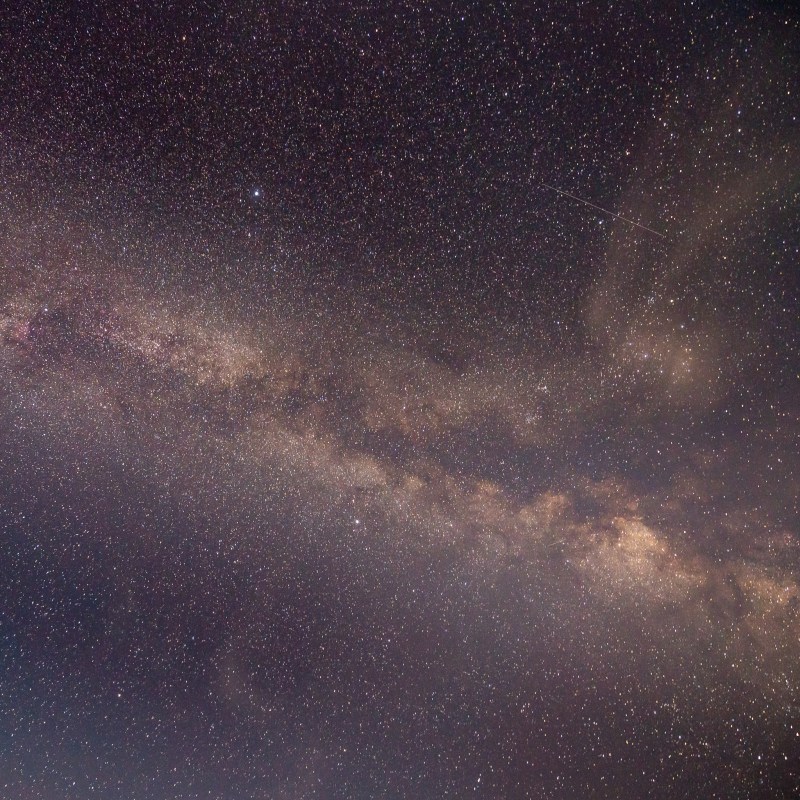
Stargazing is a luxury in itself. Busy lives may keep us from stepping outdoors to observe the night sky, but locale can be a deterrent, too — without darkness and clear skies, many city dwellers miss the special sights of the night sky. That’s where astrotourism comes in.
Videos by TravelAwaits
Unless I’m camping or visiting an observatory, it’s a rare opportunity to sit, relax, and take in the magnificence of the universe. There’s nothing like stargazing to make us realize our insignificance. The magnitude is almost overwhelming and looking at the night sky, I certainly feel small while at the same time connected to everything and everyone.
According to Astronomitaly, astrotourism — traveling to a specific place for its night sky viewing — includes observatories and planetariums, hotels and lodges, stargazing sites, and nature and national parks. For anyone wanting to learn more about astronomy, light pollution, and dark sky parks and preserves, the International Dark-Sky Association lists resources and information.
Highlighting a variety of U.S. astrotourism destinations, here we share our 8 favorite places for stargazing.
1. Door County, Wisconsin
I felt as if I had stepped back in time when I arrived on the peninsula of Door County. The area is reminiscent of lazy days along the water, and there’s no better place to relax and sit with the stars for a spell. There are several ideal spots for stargazing in Door County.
To view the night sky, it’s as easy as finding a bench at one of the town marinas. Or take the ferry to Rock Island State Park (currently closed but check back for the reopening date) to view the lighthouse and camp with a spectacular view of the dark sky. I walked the short path to the water from the lighthouse and sat for hours on a large boulder. The combination of the waves lapping against the rocks as I watched the stars was one of the most tranquil experiences I’ve had.
Near the northern tip of the peninsula is Newport State Park, the first park in Wisconsin recognized as an International Dark-Sky Park. As the park is 5 miles from external light sources you’ll see many more stars than usual. Here, many see the Milky Way with the naked eye for the first time.
For more stargazing in Door County, visit the Astronomy Campus at Crossroads at Big Creek, a 200-acre preserve. Potawatomi State Park and Washington Island both have lookout towers, too.
Pro Tips: Destination Door County provides a list of constellations along with the best locations to see them. You can also head to the Green Bay side of the peninsula to see the northern lights.

2. New Mexico
High altitude and dry temperatures lead to ideal dark sky conditions. New Mexico, set in the high desert, is one such place. While there are many places for stargazing, a few you won’t want to miss include the Cosmic Campground International Dark-Sky Sanctuary, located 8 miles north of Alma. With one of the darkest skies measured in a national park, Capulin Volcano National Monument in Capulin is another ideal destination. Clayton Lake State Park, located in northeastern New Mexico, has a 14-inch Mead telescope for viewing night skies at Lake Observatory and hosts events each month of the year.
While you’re there, here’s how to visit Santa Fe on a budget.

3. Great Sand Dunes National Park, Colorado
I was working in Alamosa a while back and during my free time on the weekends, I would drive to Great Sand Dunes National Park. Open year-round 24 hours a day, I enjoyed camping amongst the aspen forests and the tallest dunes in North America occasionally, but more often I would make the drive for a night walk on the dunes to take in the sky theater. Certified as an International Dark-Sky Park by the International Dark-Sky Association in 2019, the low light pollution, high elevation, and dry air makes for extraordinary viewing from a stunning setting.
Learn more about Great Sand Dunes National Park here.
4. Canyon Of The Eagles, Burnet, Texas
Visit Texas Hill Country to get away from the city lights and take in the peace and tranquility of a dark-sky area. Canyon of the Eagles Nature Park and Resort is situated on 940 acres of wilderness and is home to Lake Buchanon. The Eagle Eye Observatory on the property is considered one of the best astronomic viewing sites in Texas.
If you’re staying at the resort, this nature-inspired lodging has rooms without televisions or Wi-Fi, morning yoga, guided hikes with a naturalist, kayaking, plus the observatory. During my visit, dining at The Overlook Restaurant with its panoramic views, the chef-inspired menu was a high point for sampling local ingredients such as Wild Boar Jalapeno Cheese Sausage and the Chicken Fried Wild Boar.
While you’re in Texas, consider these quaint Texas towns you must visit and these 12 incredible Texas state parks for stargazing.
Pro Tip: The observatory is open to guests as well as visitors. You can also reserve a private group rental of the observatory for a special viewing experience.

5. Fall Creek Falls State Park, Tennessee
Some of my favorite hiking in the U.S. is found in state parks throughout Tennessee. Situated across the eastern top of the Cumberland Plateau, Fall Creek Falls State Park is no exception. By day you can explore several waterfalls and cascades, plus hike amongst the virgin hardwood timber. At night, head to Fall Creek Falls for its awe-inspiring views and watch the stars come out.
Read here for a Tennessee road trip that stops in some additional state parks, and don’t miss these eight stunning waterfalls in Tennessee.
Pro Tip: Tennessee state parks are free to enter and many offer stunning stargazing opportunities.
6. Flagstaff, Arizona
The train from Kansas City to Flagstaff was delayed, putting me in Flagstaff after dark. As the train rolled along, my cheek pressed against the window, I watched as the stars lit the evening sky. This was my first sampling of the dark sky of Flagstaff, which holds the title of World’s First International Dark-Sky City. I could see why.
The city honors its title and has several ways to take in the night sky. Start at the Lowell Observatory, located near downtown Flagstaff. On Friday nights, join the Cosmic Questions event, an informal discussion during which a Lowell Educator answers questions as participants view constellations through a telescope. There’s also the Giovale Open Deck Observatory where you can look through a collection of six telescopes. Or if you prefer a private experience, reserve a Premium Access experience and take a guided journey through the cosmos.
If you plan to stay the weekend, see our favorite Flagstaff suggestions here.

7. Shenandoah National Park, Luray, Virginia
One of the best places in Virginia for stargazing is Shenandoah National Park. The park is a nature lover’s dream where you can explore waterfalls and fields of wildflowers.
One way to take in the night sky is with amateur astronomer Frank Perfetti as he shares not only a love for astronomy but also aviation in his Exploring The Skies presentations.
If you prefer Twilight Hiking, join a Shenandoah Mountain Guide for a truly inspiring event. You’ll hike at dusk as the sky changes color and take in the night skies. The guide also helps you spot animal signs and seasonal plants as you explore the ecosystem of the meadows.
Or bring your binoculars and a blanket or chair to the Big Meadows Area for a free event for park visitors. During the Night Skies event, an amateur astronomer will make a presentation on controlling light pollution while pointing out constellations in the sky.
8. Natural Bridges National Monument, Lake Powell, Utah
With some of the darkest skies in the U.S., the first International Dark-Sky Park, the Natural Bridges National Monument is the perfect place for a stunning display of the night sky. The goal of a dark-sky park is to preserve and protect the dark skies and educate visitors about light pollution and ways they can make a difference.
One of the most affecting ways to stargaze is through the massive natural bridges that serve as windows into the sky. Imagine watching the Milky Way rising over the Owachomo Bridge. Since Natural Bridges’ trails are open day and night, you can explore on your own or take part in one of the presentations put on in spring and summer by Park Rangers.
For more stargazing inspiration, consider:
